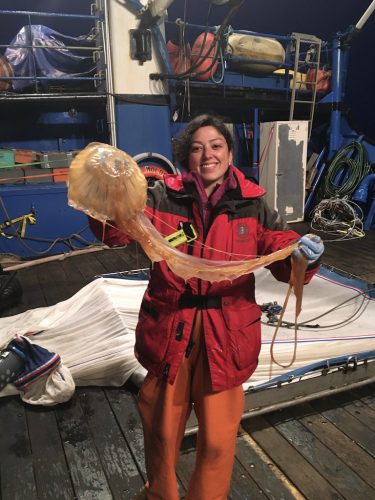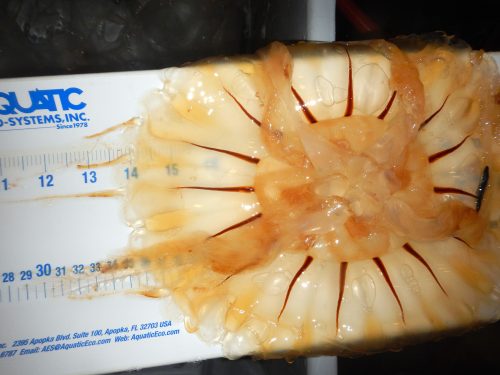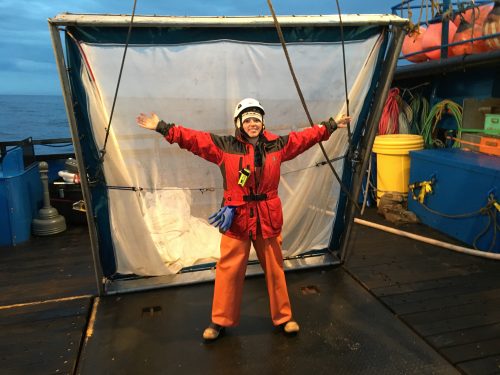Overlooked jellyfish play big role in Gulf of Alaska
April 2, 2019
Lauren Frisch
907-474-5350

“Jellyfish have superpowers,” assured Heidi Mendoza-Islas, a graduate student at the University of Alaska Fairbanks College of Fisheries and Ocean Sciences.
The voracious carnivores will eat almost anything that fits into their mouths. When conditions are good, they grow fast and multiply. When conditions aren’t ideal, baby jellies can transform into cysts and wait it out.
So it is no surprise that jellyfish have been successful predators in the Gulf of Alaska, said Mendoza-Islas.
But few studies have focused on the role jellyfish play in the gulf's ecosystem or how jellyfish affect commercially important finfish, such as pollock. Mendoza-Islas wants to change that.
Mendoza-Islas has been researching jellyfish since she was an undergraduate student at the Universidad de Baja California Sur in Mexico. She moved to Alaska to study Arctic and sub-Arctic jellies with CFOS researcher Russ Hopcroft because she was fascinated that such simple creatures could survive and flourish in cold water. She wanted to help explain why populations in Alaska thrive.
This work is critically needed for the Gulf of Alaska. While there have been a few long-term studies with components involving small jellyfish in the gulf, there has never been a systematic study specifically focused on large jellyfish. Mendoza-Islas’ project will determine how many jellies and what species live in the gulf. It will then consider how populations vary based on changes in oceanographic variables, such as temperature and salinity.
Past research has shown that jellyfish enjoy feeding on juvenile fish and fish eggs.
“So if there is a huge bloom of jellyfish in the Gulf of Alaska, we don’t know what impact that will have on pollock populations,” Mendoza-Islas said. “By synthesizing data collected from a few different long-term studies in the area and adding some of my own new data, I want to begin answering some important questions about how jellyfish impact the gulf’s ecosystem.”

Walleye pollock play a key role in the Gulf of Alaska ecosystem, said Ned Laman, a research fisheries biologist with the Alaska Fisheries Science Center. The center is part of the National Oceanic and Atmospheric Administration's National Marine Fisheries Service.
Pollock are a prominent food source for several marine fishes, seabirds and marine mammals — as well as jellyfish. Walleye pollock are also an important component of the commercial fishery landings in this region of Alaska.
“The more we know about sources of mortality affecting such a major prey species like walleye pollock in the gulf — such as Heidi's research examining jellyfish predation on young walleye pollock — the better we can anticipate changes in populations of walleye pollock and their predators,” Laman said.
Mendoza-Islas is working with two established datasets. The first contains NOAA's information on big jellies — such as lion’s mane jellyfish — which are common in the gulf. The second comes from CFOS researchers who have been measuring tiny jellyfish — such as the common pink helmet jellyfish — on the Seward Line, a set of designated sample sites across the Gulf of Alaska shelf.
To fill in some gaps in the existing datasets, Mendoza-Islas needed a bigger net than the CFOS researchers were using. With funding from the Pollock Conservation Cooperative Research Center, Mendoza-Islas and Hopcroft were able to purchase a Methot net. It covers about 5 square meters, or about the area of two sheets of plywood. The net's size and slightly coarser mesh make it the ideal tool to filter lots of water and collect larger jellyfish. In summer 2018, Mendoza-Islas collected data from all over the Gulf of Alaska during a cruise on the research vessel Sikuliaq associated with the new Northern Gulf of Alaska Long-term Ecological Research program.

Mendoza-Islas is working through the data from roughly 660 pounds of jellyfish that she caught, measured and documented last year. So far, she has found, bigger jellyfish tend to appear farther from the coast. The smaller and younger jellyfish tend to stay closer to shore. As summer progresses, jellyfish migrate away from the coast, which likely coincides with the jellies growing larger and being carried farther from shore, where currents are stronger.
Mendoza-Islas will collect a second year of data, then work through data on pollock numbers. By fall of 2019, she hopes to generate some initial tests of whether jellyfish and pollock numbers are related in the Gulf of Alaska.
“I am excited to continue to explore next steps in my project,” Mendoza-Islas said. “An understanding of the role of jellyfish in the Gulf of Alaska is required for fishery and ecosystem management.”


